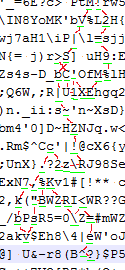25
4
Each character in this 64 by 64 block of text has been chosen randomly and uniformly from the 95 printable ASCII characters.
/rq$:Zy5*g'$DeGXX2o8y "{@Cg:FR9qih}xh >5$DsF1Fs5Ao~smFp;.RJbV )U
c4\(|Sx*V$10G9xO:NjHKasem%,\9[pPm@&kTaN~HC[;9`lgqlAH(7dt0a-5}LJ[
&sifw9V-.PLRoD~F'dJYA^Q)L#h>$9h!B4b&ceKp8~HndzDm#1/ySydrf5T8[Y%4
U9>HLQ74Qf[^V9tpWrKFcFxZJ::4?z/o]3u,V[B&hB9lFYA0:rW#yql5z9.d*D}U
:M2*O9'7_HMGw_=%@hR>O+(@Dr6MIt(=/{-{4lia0Vmws32wr(fnTmT%HSo&7!uz
\KZWG&KnXh+6E+Q>%pV(<Bnm-d+p~y~]Ta"aw9)]0A_AHz\tP3&}1R^/yPPSgN?8
".7|Uj)S7-k[`yeLO~P2a?z3wiS(R-\k'?z(pVm;;D^k/q84?&7:,E*9$UQ"UbBJ
ME]&*R ,*7PDF4Tw*-;De{YeP_al.CJcJX`@V_y+>^<h{L[^Y"!RxjN^lyA_/Y=(
#C>Zo#Sl;UUD5ChIj'L@rkELk%S*]a$87j\\n;}796m/\NPL>8d-T-hR!7ftw ?A
tV5"E309bAv$jhE6\'8f?VGlBb?z#V;F((3'|}$tfpiNB>"*mxc,X1s:/%x*JQAL
rxYXUJsd?X}^yc|'16539vd=psU'>|y/!$-TRamKcJk^2-aD35h7CcaRNue"8#{;
@yUq?*(72I8@I)So+]RwtKy:mLhjG/f#:U<TXml<PtX*+,ngfZt75-q*gSsyI2tS
|*M*;yz6u2(LZ>W`bth-7G~>|dh'pm}]@"#Oq9%o\W)b,gh%b1O]4F:EGb7ERI=@
ehMo69slKw=S@<j*Q4sfd\1')#)V&yaPF%%ZG6VK\_-$Cab,nrlW"O(<tu&xU=I&
|[g4k2L;FD)=yX0SsE-|vI(mDOccuU(+m\wxgrJxi8ZP[uD)L.!K@]%@q`!pk8Yx
?PZaS3;x,7nK~IHlrCGy~xq:@K/CJ1J^oeac&Tv?6[H>>0lu?(/bh@6J^@S?IY-|
@tdN$K=Ci2;_0Du;L2OO'en|]<_`nX5p3Bes9`8{}fRCV$X&aoQGYS'$j%r<2709
UwETsAo^d!aUZ0vN5,Yq\n%JAIm}%O88FAJK^Jt&=jM\Q1^+^|X8\._"l%hlF+yH
+c^FBFxTGz|f|#kElQs)mS64-3Z\An]|[rQo"OQ+ IP"ARdJ}/OYFQF_/{B 73mU
UPvxNByN[2TT,XgRZ_LwolUVWuR)DjYI7j#mmA8m?&Y}}[_h8@Y-R*,#=1\D*&@*
ePW.w{@z3moe3Vztd,>?*~ZQUvn8$+xw$$f92D*kPZ":;lcTr3m&{*?j$FgZK|cU
IAd'0C{<4b}NuhX1B#gmk'oF4+(@fzP^T?hF/#]g^y rb5][)X-d4Q't~1]HE"tZ
p2Z,%H0$EWF/%|UQm?&]E~=v;9YwxrSs%}df`[ `SfXMJWt86UY1duGAAKkFSrH!
oUyB[soS!N%XYwX]%n K^}CcTE?~.,8`C&l)Jjjp5|z))!o/ "G)sj,{OETsi:KE
4E,':a=,T~YlxdF^<\$fE|f:_-RG}7=m%g\-9a*X]`n<P$D+q7O`+$P&!\"NUs7n
hL@0s 7i^Xp\._4$lZIB9Ql AXX_00K=<hp%55KSO6yWH~cGe%|(p_WzlhPUbH{?
o5b4pi(,]&&jB\hGa:\DQbrYc,n|,b)_E{n~i~+JSxn?%/qJVm|B 8"Jf||L.|M-
KRxH;T^Z7%ZufyO=nI;[v1\8ZTg\_)ect4DvMTvqtoo(;b~J&'~E2TTD!w1BvGv
Q+1sv>q%1$BaCm%(\%uGH*]emoFwejkhb$gKm=DVG#&:p'";s)&MY30q_cG=.CKJ
q,aWTi|^w2wg3<G_y<n+^Xq2ymHFs#7z[x0l'Lz6N>Mpo?=hAd&58HVMhsh(kQH5
&kSivkn`,KON9xb:$M[L15!D6W?\ASWc#}V#2U;qxKhtil73,!iuG~(lr[tPJQ6w
IZ)0Vp{kEUID:vgwmTMQ#Y]NdX6{'/3bI2x9k 4[>j)&Q0U,t,iA#A%4929o6+n_
SQe/!KubbuXthMe&2\%:'Z`,aaA)V&(v+]0^v-_@*Qg!^K!pCo"@e/|3}.3q^R||
6hF>/jd>(=il~2$KY.^x~K_H)J8Fi)'LOcUr4xJir^v0,c fIsoT<|7K}Bls|36z
MQ|-w=bp)_EY>YtGcW)!@/|Lc:I_<]x.~[|QSgJY1ZX9^e`ojAR6U#zt9!,44}>#
EJzH \gwosC>Z*)H!]1BPaIEYGyk{c0zv{d\#px2@#'-T{{.Qxknxv}"x3#K]w>;
<X(\bNnY_6*7Yu7_3a+wInwt vh=1eBgz>7Bnhs!<t.T#&V{+?p+{.RTN:xz>|,E
$upN*[F4A`~ZDMDt{.&2z+LZ7bcfeJfF9Uy3xX]ZzQ1FvB.U4S!hm$LYCp: wF7h
47-+lY$"}AExXQ@?!/6}biptH=6N-6&8-T\C8{`i56e'%cimv,0QKYTx) "nkFJ
C:Enw=Q%6J;t6wS+2O,b0v'"OK6GMbr);y#-H86>pCE6wjdk*rR*=reWo57^2TFH
::Nq,t9_S">\o^NZzh|U\^qyh-yt0nvMs%'6\;$%(91gTC=&1q]q-*u*so KrXsE
-Sz>q]l86[OO@\5W<'\XDc,%/=0sV0&1'Etty%f ~,c45IIqy=no.DY{8\?fa<9{
6%3TP:i^q.JzU217CADu}iAzWT""E\{IEMbGDKZB6s*LmlM0|<WA8CP7sR}f?WSL
S`T} 7Tn9!h8P\W 8J\#Mg\o;Qwt&4\UYKf{)O3G&B]sK.bw1!?7=:h$IIOIakD<
H/O5v`ld*35MSsydSQoiAnJ*\!^?'_=6E?c> PtM!rw5y{ZT2xSco){3_?j|wtJp
CT1!e~k8aNgw)LE:}oX4R*<u]TB%\IN8YoMK'bV%L2H{L3'c/|xoTY^&&WPKSyo<
cXma$Rfjj^':^a\?$UOo48]791Wywj7aH1\iP|\l=sjjbjqZB2)-apvjV@q47Spw
OP[kT<l@cKB="n;VC#6a*InmS~$TN{= j)r>S] uH9:E-}y>.Ygc'll$5Y$j]AYt
jB="iGo7[qY~A*nv.\51[<]):^[iZs4s-D_bC'OfM%lHlz;MoxY$Ku]NCt72PYMB
_(myN5'%] C!7FPoGX7+*,Yptuaz;Q6W,;R|U1XEhgq21R7<ncnDB<D_);j.:r0r
Q6!k|Dq`!Jz7l="*n?w@f|h=PA_A)n._ii:s~'n~XsD}?JRIkC9AW^piUfBTU,ui
nf+yZ`7P-(@{>s:{Vz'N 7qB&+UZbm4'0]D~HZNJq.w</3 \cL)WRDP(y]w~L4N/
!!lA+NK[+9#-iwx`PE53D.K2]]#M.Rm$^Cc'|!@cX6{yCg8K0|>E_jyup|+'=#c%
Ao5$B);DoQ#jg[7GbdE+o:R,T#@`;UnX}.?2z\RJ98Se*_.*e8mCUF}Vw1u13cy1
2s}1@?{0);Jo6(J@l>[M 0CkeO6{ExN7,%Kv1#[!** czaX)=;Q~D;z',fkq!1W<
% f(i#i`PQY!m7v#D:j5pyU]8:at2,k("BWZRI<WR??GQ$^1d[m,F(<e5CLv-m*B
CD)zVpa95WpJ K@&}yN\Q8I<%z/*_/bPsR5=0\Z=#mWZDAfA5[k|$Yks@Q;@h,s/
Np.$gTvz>T+"0|$Nw::%m$GFYxG{2akv$Eh8\4|eW'oJEffNzJ>UxU4>oITZMe/'
EMg$>kD|\ ^.W)Stzv/7z\^bdi]E@] U&-r8(B^?}$P56[?e~jE#_j)5=#~.yNP$
'mgF3EAhXB 55)\WXp*e+fD#^&SHGx++7VO[R7*b(Q+:jESt'K%m~d$Bv^/{7=zr
5oCZDp& ;*Y*G`L$C]Nm`|^:y2NKaO!)u/{hwm(VjS`<qKgNw7[+~0 <be'sWjTo
.3!sPGuFFZ@9.4u*ml)pLeEVJ~8A$mgz*d>ajbg1FIYrg6J`D0xJMXi`ghA1V$ju
*rJg/ o;6M7`(qTF.nO'4da,{ieM&NC9rg;nX*))*DK"DycYD66&6z/I@}y4@$<f
3S]~9g An{=Rj|y&A2Vh^F\3lb#N~8w0EMx<K$]z(eZS~zbmgeeV\i7,MY~zrc+;
Your task in this challenge is not to write your own code, but rather to extract code from this block of text as if it is a huge Boggle grid and you're looking for a runnable program instead of a word.
The submission with the program that produces the longest finite output wins.
Details
Treat the 64 by 64 grid of text exactly like a 64 by 64 Boggle grid with additional characters. Construct a string that is a runnable program in some language by choosing a starting location in the grid and repeatedly moving one step vertically, horizontally, or diagonally (8 directions total) as many times as you want. You may NOT use the same grid space more than once!
For example, these 4 lines were taken from near the middle of the text block:
EJzH \gwosC>Z*)H!]1BPaIEYGyk{c0zv{d\#px2@#'-T{{.Qxknxv}"x3#K]w>;
<X(\bNnY_6*7Yu7_3a+wInwt vh=1eBgz>7Bnhs!<t.T#&V{+?p+{.RTN:xz>|,E
$upN*[F4A`~ZDMDt{.&2z+LZ7bcfeJfF9Uy3xX]ZzQ1FvB.U4S!hm$LYCp: wF7h
47-+lY$"}AExXQ@?!/6}biptH=6N-6&8-T\C8{`i56e'%cimv,0QKYTx) "nkFJ
Starting with the p near the right end of the third line I can move to the by going diagonally down and right, then to the " by going right, then up 3 times over zK, and left 4 times over #3x". This traces out the string p " zK#3x" which when run as a Ruby program outputs " zK#3x".
The goal is to find a program that produces the longest finite output. Only printable ASCII characters are considered when counting the length of the output (this means tabs and newlines are not counted), though other characters may be present. The Ruby example only produces 8 characters.
Also...
- The program may be from 1 to 4096 characters long.
- The program may not contain tabs, newlines, or non-printable ASCII (as they aren't in the grid).
- The program should run and exit without errors.
- There are no time or complexity constraints as long as the program would eventually terminate with finite output.
- The grid does not loop around from left to right or top to bottom.
Please mention where your program appears in the grid so we can quickly verify that it really is there.

inb4 a "given a boggle board and a word, verify the word exists on this board" challenge. – John Dvorak – 2015-01-16T10:03:03.973
8Why the 4096 character rest... oh. – John Dvorak – 2015-01-16T10:04:56.443
2Maybe it would have been more interesting if the program had to solve an actual code golf problem, but be taken from the grid. – feersum – 2015-01-16T11:47:15.093
Clearly not a viable challenge for Mathematica, which has a mean function name length of 13 characters! – DavidC – 2015-01-16T15:17:39.130
2@DavidCarraher - Or for any non-golfing language actually. I found one instance of
yes, for example. – None – 2015-01-16T15:48:27.493@feersum I agree, though then solutions might even be less accessible for non-golfing languages. Maybe if I had weighted it so letters, spaces, and semicolons were more common. – Calvin's Hobbies – 2015-01-16T18:13:35.577
1TECO is not a golfing language...it is a tape/text editor dating from the 1960s. – feersum – 2015-01-16T23:06:18.020
1Looks like perfectly viable perl program at first glance... – DGM – 2015-01-17T00:48:58.070
@Calvin'sHobbies A sequel to this sounds fun – Sp3000 – 2015-01-17T09:16:23.020